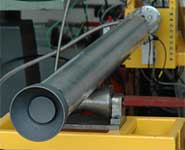All of last month’s seven preliminary tests by engineers at Airborne Engineering and the University of Bristol used a conventional conical nozzle. This month the team test fired an ED nozzle for the first time. Sadly, the experimental graphite nozzle suffered a failure a short time after ignition.
The team is up beat about the failure, which was caused by a combination of heat-induced and pressure-induced stresses in the graphite nozzle.
“We expected some teething-trouble with the ED design,” said James Macfarlane of Airborne Engineering. “It is a tricky shape to make from graphite and the loads are quite high so we knew we might have to make some changes.”
Despite the failure, there are no risks to plans or schedule and a redesign of the nozzle is under way.
Mark Hempsell, Future Programmes Director at Reaction Engines Ltd and Visiting Fellow in Aerospace Engineering at Bristol University, said: “Problems of this sort are to be expected in an experimental programme. It is part of the learning process, which is why we do them.
“Reaction Engines continue to be very excited about the Canary project which will continue to encourage and support the team.”

